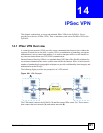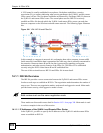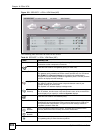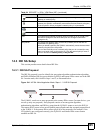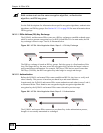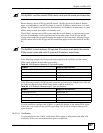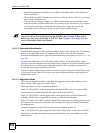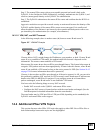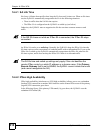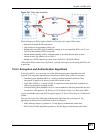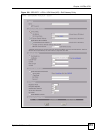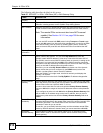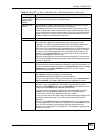
Chapter 14 IPSec VPN
ZyWALL 2WG User’s Guide
308
• Instead of using the pre-shared key, the ZyWALL and remote IPSec router check each
other’s certificates.
• The local ID type and ID content come from the certificate. On the ZyWALL, you simply
select which certificate to use.
• If you set the peer ID type to Any, the ZyWALL authenticates the remote IPSec router
using the trusted certificates and trusted CAs you have set up. Alternatively, if you want to
use a specific certificate to authenticate the remote IPSec router, you can use the
information in the certificate to specify the peer ID type and ID content.
" You must set up the certificates for the ZyWALL and remote IPSec router
before you can use certificates in IKE SA. See Chapter 15 on page 349 for
more information about certificates.
14.3.1.3 Extended Authentication
Extended authentication is often used when multiple IPSec routers use the same VPN tunnel to
connect to a single IPSec router. For example, this might be used with telecommuters.
Extended authentication occurs right after the authentication described in Section 14.3.1.2 on
page 306.
In extended authentication, one of the routers (the ZyWALL or the remote IPSec router)
provides a user name and password to the other router, which uses a local user database and/or
an external server to verify the user name and password. If the user name or password is
wrong, the routers do not establish an IKE SA.
You can set up the ZyWALL to provide a user name and password to the remote IPSec router,
or you can set up the ZyWALL to check a user name and password that is provided by the
remote IPSec router.
14.3.1.4 Negotiation Mode
There are two negotiation modes: main mode and aggressive mode. Main mode provides
better security, while aggressive mode is faster.
Main mode takes six steps to establish an IKE SA.
Steps 1-2: The ZyWALL sends its proposals to the remote IPSec router. The remote IPSec
router selects an acceptable proposal and sends it back to the ZyWALL.
Steps 3-4: The ZyWALL and the remote IPSec router participate in a Diffie-Hellman key
exchange, based on the accepted DH key group, to establish a shared secret.
Steps 5-6: Finally, the ZyWALL and the remote IPSec router generate an encryption key from
the shared secret, encrypt their identities, and exchange their encrypted identity information
for authentication.
In contrast, aggressive mode only takes three steps to establish an IKE SA.
Step 1: The ZyWALL sends its proposals to the remote IPSec router. It also starts the Diffie-
Hellman key exchange and sends its (unencrypted) identity to the remote IPSec router for
authentication.




